Are you visiting Marrakech? Please, if there is one thing that should jump straight to the top of your list to visit, let it be Bahia Palace in Morocco (pronounced Bah-eeee-a Palace rather than Bah-i-a Palace!) This phenomenal 19th Century Palace amazed me, and, although I may hate to admit it, I liked it more than the famous Alhambra Palace in Grenada! This palace has vibrant geometric tiles, stucco carved with Arabic inscriptions, and detailed wooden carved panelling. Bahia Palace is a must-see if you would like to enjoy the beauty of Moroccan architecture.
Disclosure: templeseeker.com is a participant in the Amazon Services LLC Associates Program and other affiliate advertising programs designed to provide a means for us to earn fees by linking to Amazon.co.uk, Get your Guide and other affiliated sites. Affiliate links may be used in this article on ‘Bahia Palace Morocco’, but they do not impact on the price that you pay and they do help me to get this information to you for free.
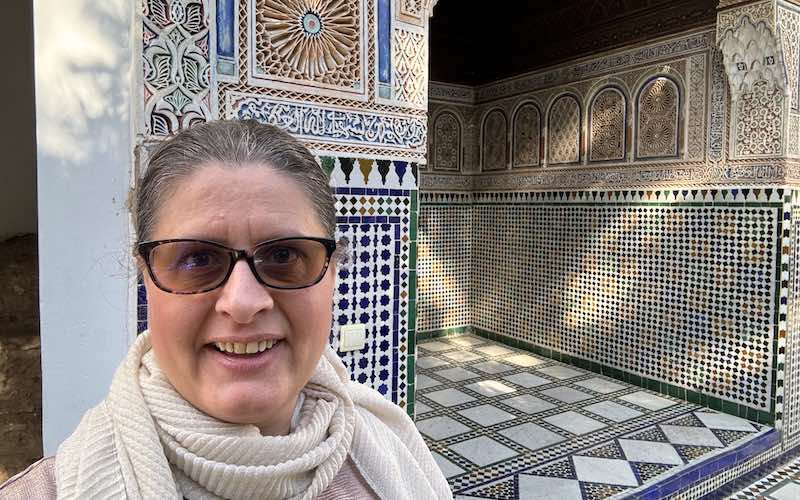
How to get to Bahia Palace Morocco
Most people fly into Marrakech or Casablanca to visit Vahia Palace in Morocco. Marrakech Menara Airport (RAK) is the most convenient and if possible you should fly to Marrakech and stay in a Riad on the South side of the Medina which is walkable to the palace.
Flying into Morocco to Visit Bahia Palace
To visit Bahia Palace, most people fly directly into Marrakech (Ryanair and Easyjet have flights direct to Marrakech from destinations including Manchester, London and Bristol). From Marrakech airport to your Medina in Marrakech you should pay between 70-100 Dirhams for your taxi. The cream taxis are the official ones and you should avoid the tours and ask for one that is at the end of the queue and not bothering you or anyone else!
Some people fly into Casablanca and then travel from Casablanca to Marrakech to see Bahia Palaca in Morocco. In Casablanca, you shouldn’t pay more than 300 Dirhams from Casablanca airport to downtown Casablanca. To get from Casablanca to Marrakech, I recommend taking the train which is the fastest and most comfortable option. It is also great value for money (I think we paid around £15 each for first a first class ticket!) You can pre-book trains on the official ONCF website, or turn up and buy them at the ticket office in the station.
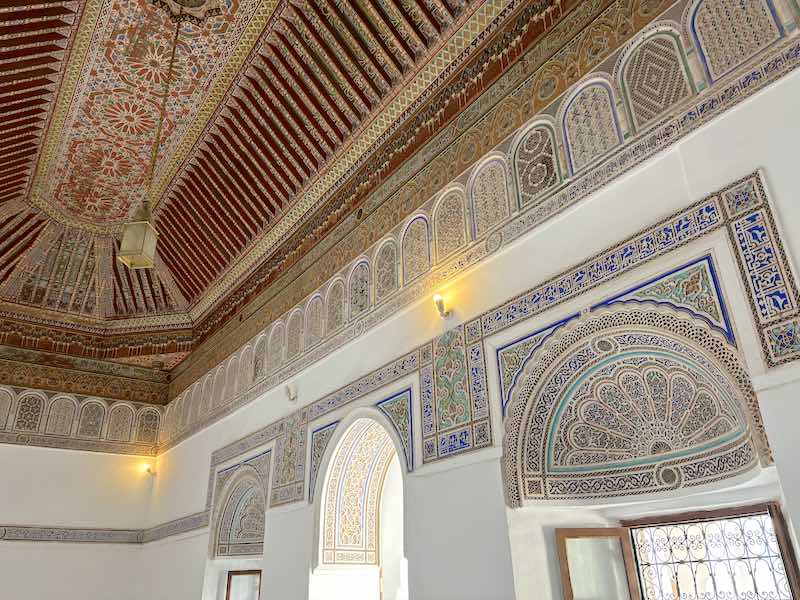
Photography copyright: All the images in this blog are original photography by Amy Green and are property of @templeseeker (unless otherwise stated). Please do not use these without permission or without giving credit. If you would like to use any of these images please email: amy@templeseeker.com for permission.
Getting to Bahia Palace once you are in Marrakech
You should stay in a Marrakech Riad that is within the Medina walls. Then you can probably walk to Bahia Palace, or you can jump in a taxi (the official cabs are cream coloured in Marrakech) and you should not pay more than 25-30 Moroccan Dirhams for trips within the Medina.
I recommend that you stay at Riad Carina, which is a beautiful traditional Marrakech Riad close to the Bahia Palace – you will be able to walk there within around 10 minutes.
When you walk to Bahia Palace, there will be many boys or ‘touts’ who will tell you ‘it’s closed!’ ignore them – it’s probably not (it’s open daily from 9am-4pm). They shout ‘it’s closed’ in Marrakech because they want you to believe them and then they will take the opportunity to become your unofficial rip off guide, or take you to there uncle/fathers/friends shop where you will be likely ripped off and receive commission! You can just smile and say ‘it’s not closed!’ or say a polite but firm ‘no thank-you!’ Bahia Palace is clearly labelled and look for the big arch with the sign for it.
There is also no ‘gate man’ at Bahia Palace! In other words, you are not to pay anyone for the privilage of walking through the Bahia Palace first arch! If someone tries it on, walk past them, and go straight in to the official ticket office.

What is the entrance fee for Bahia Palace in Marrakech
At the time of writing, the cost of the entrance fee for the Bahia Palace was 70 Dirhams. This works out at about £6.50-£7 or $7. You can buy your tickets on the door (through the gate and then you will see the actual ticket kiosk) and you don’t have to book in advance, although you may want to if you feel that you need a guide. If you do want a guide, book it in advance online with a reputable company such as Get Your Guide.
What to Wear to Bahia Palace
It is recommend that you dress conservatively for Bahia Palace. Women should cover their legs and shoulders. Men and women should avoid shorts and women should avoid short skirts. Wear comfortable shoes as you will be on your feet for some time.
How long to spend at Bahia Palace
You should plan to spend at least 1-2 hours in Bahia Palace, including photography, and follow this by visiting the nearby Saadian Tombs. The earlier that you get to Bahia Palace the better, to avoid the tour groups who come through. If possible, I would recommend visiting from 9-11am.
What are the Opening Hours of Bahia Palace?
The Palace is open most days from 9-4pm. The latest that you should arrive is around 2pm to ensure that you have enough time to look around.
History of Bahia Palace
The first foundation stone of Bahia Palace was set in 1866 L by Abu Imran Musa bin Ahmed bin Mubarak Al Shari Al Bukhari, who was the chamberlain, minister and Grand Vizier for both Alawite Sultans Sidi Muhammad Ben Abderrahmane (1859-1873) and Al Hassan the first (1873-1894). Later on, it was expanded and decorated in the reign of the chamberlain’ son Mr. Ahmed Ben Mousa, or as he was called (Ba-Hmad), who was also the Hajib of the Sultan Al Hasan the first and Grand Vizier of the Sultan Moulay Abdelaziz (1894-1908).
When Ba-Hmad passed away in 1900, Bähia palace was added to the collection of the roil palaces. Then, the Grand Vizier El Madani El Glaoui built the upper floor of the palace. After that, the French Resident General, the Marshal Lyautey turned the palace into an official headquarters of the French residence general in Morocco between 1912 and 1956.
When Morocco gained its independence, the palace became a Royal residence for the Sultan Mohamed the fifth, then for the prince Moulay Abdellah. Later on, it was entrusted to the ministry of culture by the king Al Hassan the second as a national historical monument based on Dahir of 21december 1924.
Layout of Bahia Palace
The palace occupies more than 37100 m2 of buildings in addition into 5 hectares as green spaces, and it is divided into the following parts:
- Dar Si Mousa: The core of the palace (1866-1878): It consists of the big external yard, or BaH mad’s Agdal, the big Riad that contains two opposite and large rooms and an open courtyard and the northeastern annex that holds the grand square and its numerous amenities
- The expansions of Ba Hmad “Adar Elbahia”.:(1894-1900): It is the new residence that was built by Ba-Hmad for housing his family and servants, by the assistance of the Moroccan Expert Architect Al-Makki al Masfiwi, (1857- 1926), who was skillful in the Moroccan traditional handicrafts.
- Ba-Hmad bought all the houses and gardens around the palace so that he would be able to build the new added parts to the palace that provide the space for the small Riad and courtyard and the marble square as well as other amenities and annexes, this cost Ba-hmad approximately one million and half gold francs.
The Small Riad
This part is the most recent in comparison to the other components of the Palace. It is a small square
indoor garden (1) onto which a number of rooms (3-4-5), niches (2) and side-rooms open up.

The small Riad stands out for its classic structure and its densely decorated arcades, niches, rooms, ceilings, door and window panels and marble basin located in the centre of the garden. That is where Ba-Ahmed used to receive the government members in the so-called large council room (6), with its prestigious artisanal ceiling in cedar wood, painted designs, remarkable shape and three air vents. This is also where private apartments were equipped for the French General-Resident as of the year 1912.

The Small Courtyard
The small courtyard is a patio with four rooms symmetrically arranged around it. One of these rooms was once adorned with glass offered by the French government to Ba-Ahmed in 1898.
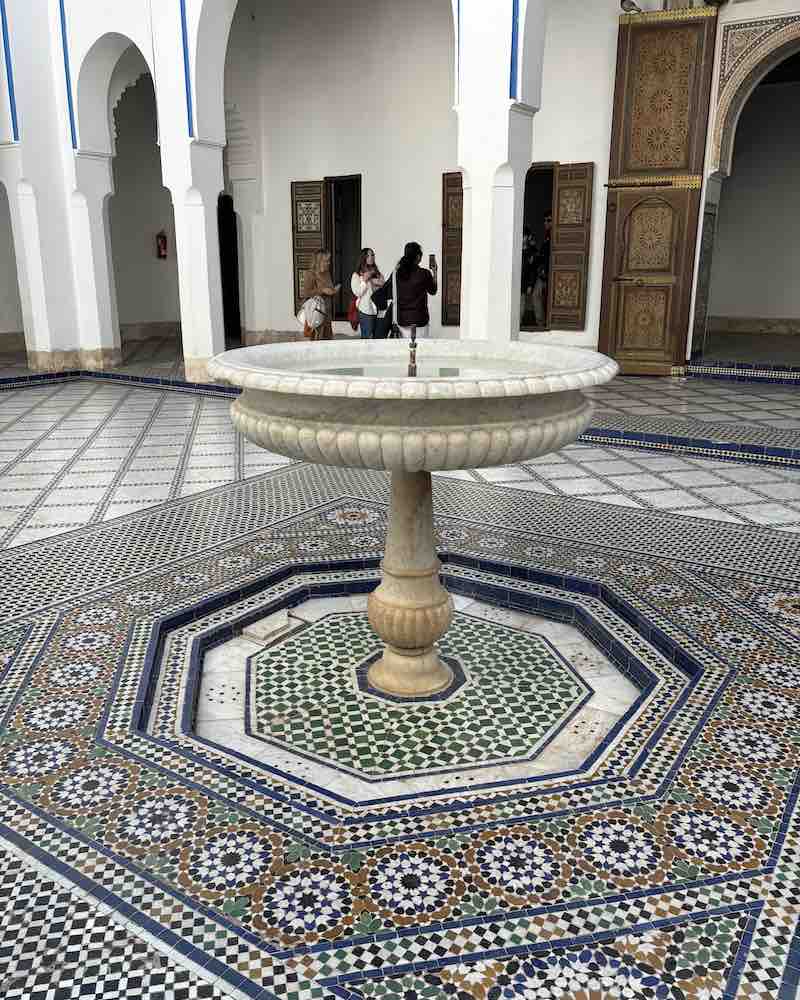
This complex, which was paved entirely in marble and ceramic tiles, constituted Ba-Ahmed’s private apartments. As from 1912, the rooms were converted into bedrooms for the French officers. The ceilings together with the door and window wings, made of cedar, are all noteworthy.

Main Courtyard
The main courtyard is the largest and most impressive main section of Bahia Palace.

Large Riad or the Grand Riad
It is the oldest part in the Palace (1866 -1867). It was once built by Ba Ahmed’s father, Si Moussa,
and restored at a later stage. It is a vast indoor garden, with three marble basins, and onto which open up two niches and two large rooms. These rooms stand out thanks to their compact and refined decoration: floor and wall tiling (half way to the top), panels of sculpted and painted plaster, and ceilings made of cedar wood with painted motifs.


Noble Wife’s Apartment
It has been designated as ‘The noble wife’s apartment’. Ba Ahmed’s wife was Pacha Ben Daoud’s sister, Lalla Zineb. The construction of this part completed in 1898, and it includes two rooms and two niches, opening up onto an indoor covered area with a flat ceiling made of cedar wood and ventilated and lit by sculpted and delicately chiseled plaster panels.
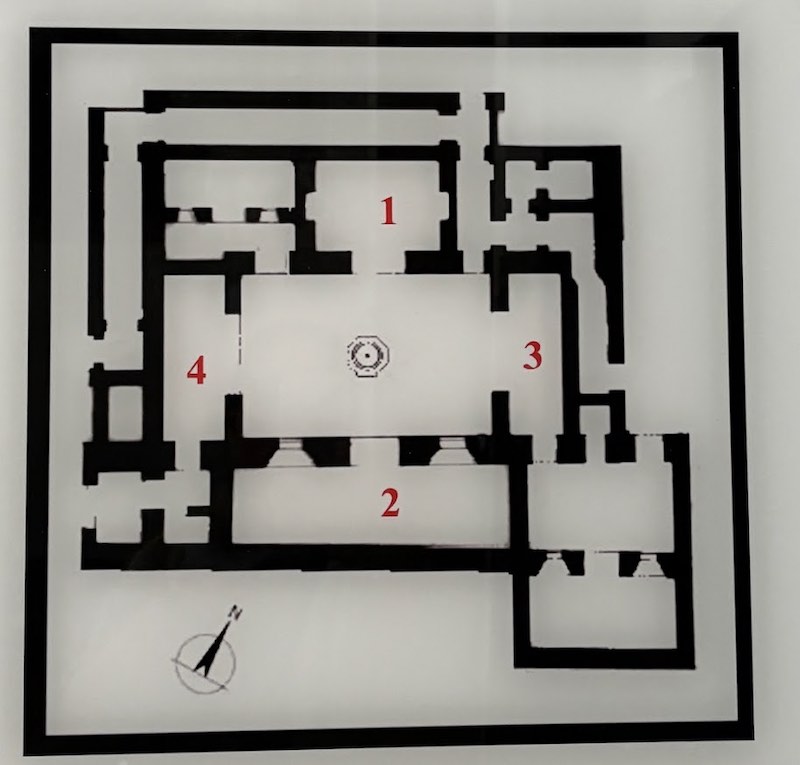
The ceilings of the rooms and niches, the lintels, the door and window wings are also made of cedar wood, enhanced with painted motifs and namely with stylish bouquets of flowers.
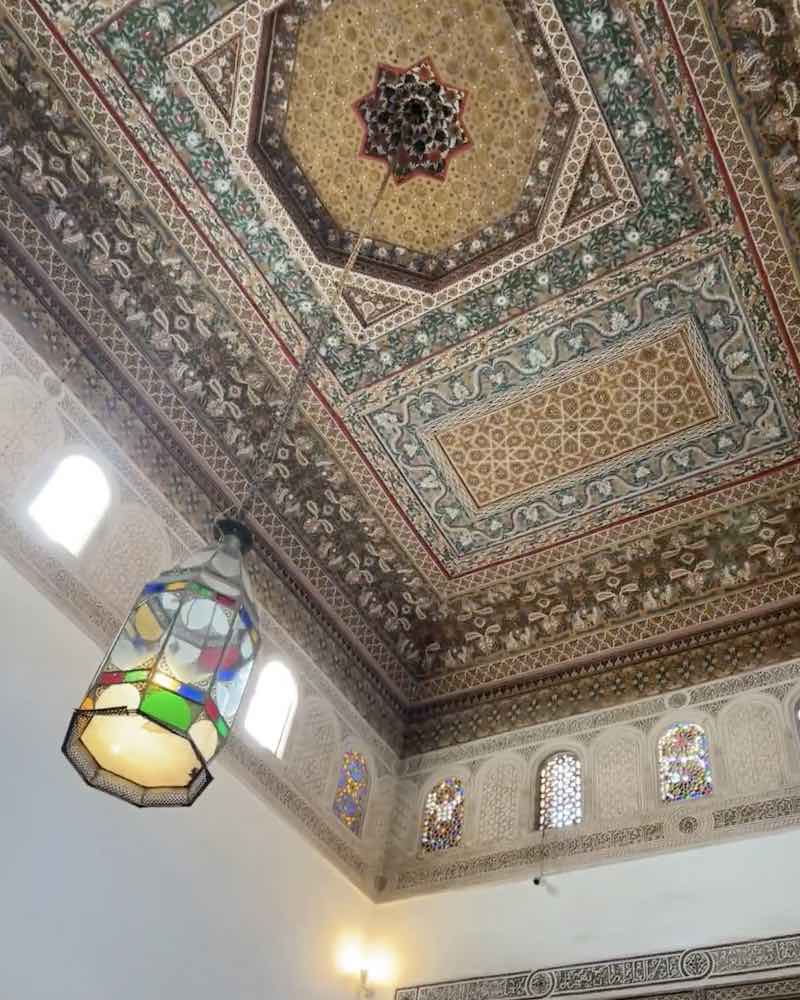
After the Bahia palace, I recommend that you walk to the Saadian Tombs, which are about 15 minutes away. You will see impressive architecture surrounding the Royal graves. It is just 70 Dirhams to visit the Saadian tombs. Watch out for the ‘snake man’ at the gates – he has a tendancy to put a snake on you and demand extortionate amounts of money for a photo!
When you come out of the Saadian tombs, grab a drink or some lunch at the ‘Kasbah Cafe!’
Further Reading on Morocco
If you enjoyed this article on the Bahia Palace Morocco then you might also like to read about the following…
- Visiting Marrakech in December
- Is Morocco worth Visiting
- Things to do in Marrakech
- Is Casablanca worth visiting?
